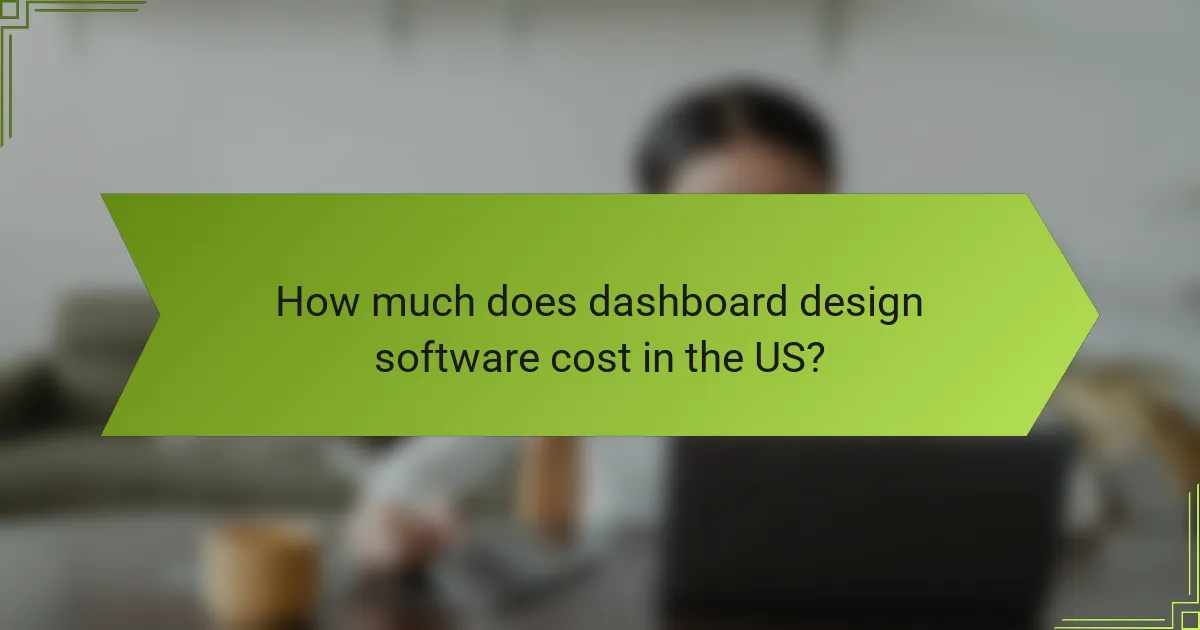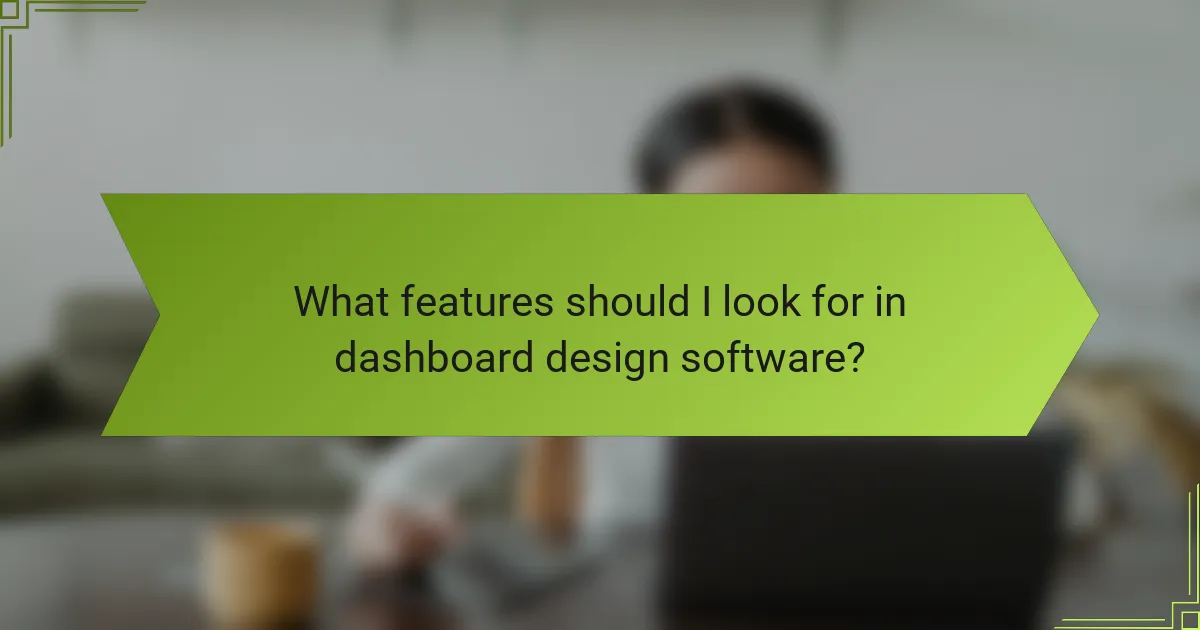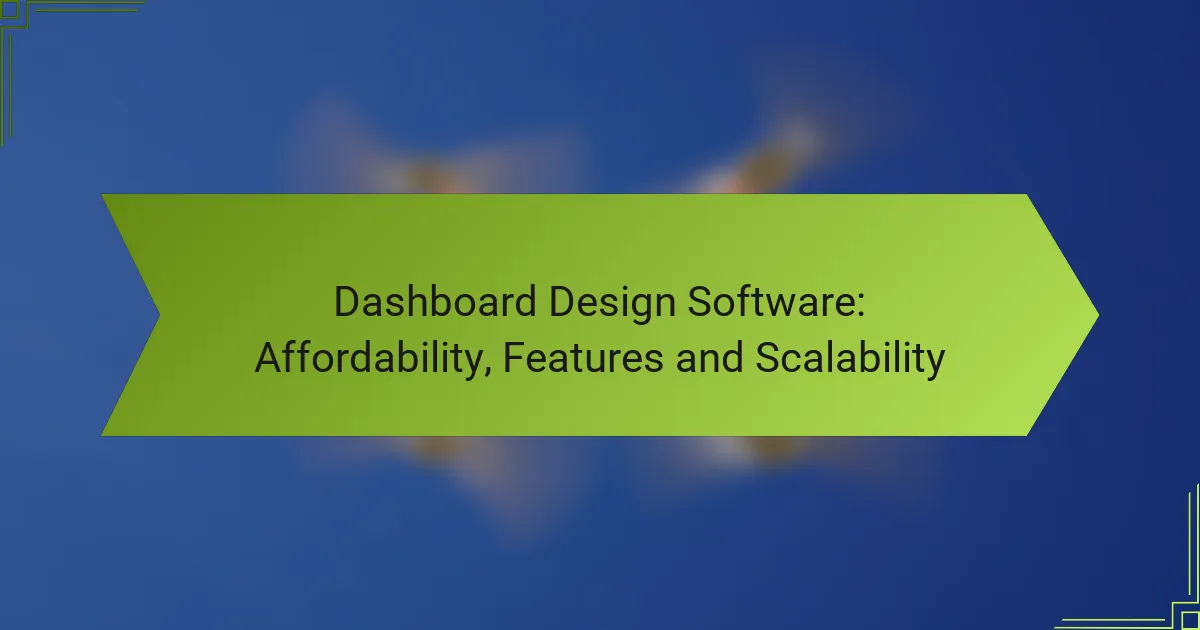Choosing the right dashboard design software is crucial for effective data visualization and analysis. With options like Tableau, Microsoft Power BI, and Google Data Studio, users can find tools that fit various budgets and feature requirements. Understanding the cost structures and scalability of these solutions will help ensure that you select a platform that meets your current and future needs.

What are the best dashboard design software options?
The best dashboard design software options include Tableau, Microsoft Power BI, Looker, Qlik Sense, and Google Data Studio. Each of these tools offers unique features and pricing structures, making them suitable for different needs and budgets.
Tableau
Tableau is a powerful data visualization tool known for its user-friendly interface and robust analytics capabilities. It allows users to create interactive and shareable dashboards that can integrate with various data sources.
Consider Tableau if you require advanced analytics and extensive customization options. Pricing typically starts in the low hundreds of USD per user per month, which can add up for larger teams.
Microsoft Power BI
Microsoft Power BI is a cost-effective solution that integrates seamlessly with other Microsoft products. It provides a range of data visualization options and is particularly beneficial for organizations already using Microsoft 365.
Power BI offers a free version with limited features, while the Pro version is usually priced around $10 per user per month. This makes it an attractive option for small to medium-sized businesses looking for affordability and scalability.
Looker
Looker is a cloud-based platform that focuses on data exploration and business intelligence. It allows users to create custom dashboards and reports using LookML, a proprietary modeling language.
Looker is ideal for organizations that prioritize data governance and collaboration. Pricing is generally on the higher end, often requiring a custom quote based on user count and features, making it more suitable for larger enterprises.
Qlik Sense
Qlik Sense is known for its associative data model, which allows users to explore data freely without being confined to predefined queries. This flexibility makes it a strong choice for data-driven decision-making.
Qlik Sense offers a free version with limited capabilities, while the full version can cost around $30 per user per month. This pricing structure can be beneficial for teams that need advanced analytics without a hefty upfront investment.
Google Data Studio
Google Data Studio is a free tool that enables users to create customizable dashboards and reports using data from various Google services and other sources. Its ease of use and integration with Google Analytics make it a popular choice for marketers.
While Google Data Studio is free, it may lack some advanced features found in paid software. It’s an excellent starting point for individuals or small businesses looking to visualize data without incurring costs.

How much does dashboard design software cost in the US?
The cost of dashboard design software in the US varies widely based on features, scalability, and the pricing model of the provider. Generally, users can expect to pay anywhere from a few dollars per user per month for basic tools to several hundred dollars for advanced solutions with extensive capabilities.
Tableau pricing tiers
Tableau offers several pricing tiers to accommodate different user needs. The pricing typically starts at around $12 per user per month for the Tableau Viewer, which provides basic access to dashboards, while the Tableau Creator, which includes full authoring capabilities, can cost approximately $70 per user per month.
Organizations should consider their requirements carefully when choosing a tier, as the higher-priced options unlock more advanced features like data preparation and extensive analytics capabilities.
Microsoft Power BI pricing
Microsoft Power BI provides a cost-effective solution, with pricing starting at about $10 per user per month for the Power BI Pro version. This tier allows users to create reports and dashboards and share them within their organization.
For larger enterprises, Power BI Premium offers additional features and dedicated cloud resources, starting at around $20 per user per month or a flat fee for capacity-based pricing, which can be more economical for larger teams.
Looker subscription costs
Looker’s pricing model is generally based on the number of users and the data volume processed. While specific pricing details are often customized based on the organization’s needs, estimates suggest costs can start at around $3,000 per month for smaller teams.
Companies should evaluate their data requirements and user base to determine the most suitable plan, as Looker is designed for scalability and can become a significant investment for larger deployments.

What features should I look for in dashboard design software?
When selecting dashboard design software, prioritize features that enhance data visualization, integration capabilities, user interface design, and collaboration tools. These elements will significantly impact the effectiveness and usability of your dashboards.
Data visualization capabilities
Data visualization capabilities are crucial for transforming complex data into understandable graphics. Look for software that offers a variety of chart types, such as bar graphs, line charts, and heat maps, to effectively represent different data sets. The ability to customize visuals is also important, allowing users to tailor dashboards to their specific needs.
Consider tools that support real-time data updates, as this ensures that the visualizations reflect the most current information. Additionally, check for features like drill-down capabilities, which let users explore data at a more granular level.
Integration options
Integration options determine how well the dashboard software connects with other tools and data sources. Ensure that the software can seamlessly integrate with popular databases, APIs, and business applications like CRM or ERP systems. This connectivity is essential for pulling in data from various sources to create comprehensive dashboards.
Look for platforms that support both native integrations and third-party connectors. This flexibility allows for easier data management and ensures that you can adapt the software to your existing tech stack without significant hurdles.
User interface design
A user-friendly interface is vital for ensuring that all team members can navigate and utilize the dashboard effectively. The software should feature an intuitive layout, easy-to-use drag-and-drop functionality, and clear navigation menus. This simplicity enhances user adoption and reduces the learning curve.
Check for customizable themes and layouts that allow users to create dashboards that align with their preferences. A responsive design that works well on various devices, including tablets and smartphones, is also beneficial for on-the-go access.
Collaboration tools
Collaboration tools facilitate teamwork and communication within the dashboard software. Look for features that enable sharing dashboards easily with team members or stakeholders, such as export options and real-time editing capabilities. These tools enhance collective decision-making and streamline workflows.
Consider whether the software includes commenting or annotation features, allowing users to provide feedback directly on the dashboard. This functionality can significantly improve collaboration and ensure that all team members are aligned on data insights and actions.

How scalable is dashboard design software?
Dashboard design software varies in scalability, which refers to its ability to handle increasing amounts of data and users without compromising performance. A scalable solution can grow with your organization, accommodating more complex data sources and larger user bases efficiently.
Scalability of Tableau
Tableau is known for its strong scalability features, allowing users to manage large datasets and numerous concurrent users effectively. It supports various data connections, from simple spreadsheets to complex databases, making it suitable for organizations of different sizes.
As your data needs grow, Tableau can scale through its server architecture, enabling distributed processing and load balancing. This ensures that performance remains steady even as the volume of data increases.
Scalability of Microsoft Power BI
Microsoft Power BI offers robust scalability options, particularly for businesses already using Microsoft products. It can handle large datasets and integrates seamlessly with Azure services, which enhances its capacity to scale.
Power BI’s cloud-based model allows for easy expansion, enabling organizations to add users and data sources without significant infrastructure changes. However, users should monitor performance as data complexity increases to avoid slowdowns.
Scalability of Qlik Sense
Qlik Sense provides excellent scalability, designed to support both small teams and large enterprises. Its associative data model allows users to explore data freely, accommodating growth in data volume and user numbers without sacrificing speed.
Qlik Sense can be deployed on-premises or in the cloud, offering flexibility in scaling according to business needs. Organizations should consider their data architecture and user requirements to optimize performance as they scale.

What are the prerequisites for choosing dashboard design software?
Choosing dashboard design software requires understanding your specific needs, budget constraints, and the scalability of the solution. Key factors include the features you require, integration capabilities, and user-friendliness.
Affordability
Affordability is a critical factor when selecting dashboard design software. Prices can range from free basic versions to premium subscriptions costing hundreds of dollars per month. Assess your budget and consider both initial costs and ongoing expenses, such as maintenance and support.
Look for software that offers tiered pricing models, allowing you to choose a plan that fits your needs. Many providers offer free trials or demo versions, which can help you evaluate the software before committing financially.
Features
Features are essential in determining the right dashboard design software for your organization. Common features include data visualization tools, customizable templates, and real-time data integration. Make a list of must-have features versus nice-to-have options to guide your selection process.
Consider whether the software supports the data sources you use, such as databases, spreadsheets, or cloud services. Additionally, check for collaboration features that allow team members to work together effectively.
Scalability
Scalability refers to the software’s ability to grow with your organization. Choose a solution that can handle increasing data volumes and user numbers without compromising performance. This is particularly important for businesses anticipating growth or changes in data needs.
Evaluate whether the software can integrate with additional tools or platforms as your requirements evolve. A scalable solution should also provide options for upgrading features or capacities without requiring a complete overhaul of your system.
